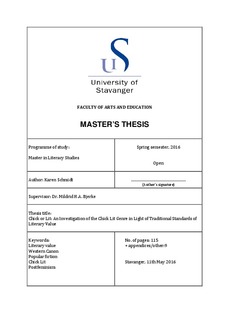| dc.description.abstract | The present master’s thesis explores the chick lit genre in light of traditional standards of literary value. The thesis investigates how literary value and quality has been defined through the last couple of centuries, as well as how popular fiction, and chick lit in particular, is evaluated in terms of literary value and quality. The thesis seeks to understand how the popular embrace of genre fiction, like chick lit, relates to the typical critical rejection of such writing. Ultimately, the motivation behind the present thesis is to reach an understanding of why it is necessary to discriminate between good and bad writing, and whether it is possible to discuss literary value and quality without such a binary mode of thinking.
The thesis’s first body chapter explores how literary value and quality has been defined in the past. Central works are Matthew Arnold’s Culture and Anarchy (1882[1869]) and ‘The Study of Poetry’ (1880), Q.D. Leavis’s Fiction and the Reading Public (1932), F.R. Leavis’s The Great Tradition (1960[1948]) and Culture and Environment (1977[1933]) and Terry Eagleton’s Literary Theory (2008[1983]). The chapter aims to show on how these critics have defined literary value and quality, and how they have considered the position of popular fiction.
In the second body chapter, Harold Bloom’s The Western Canon (1995) and Janice Radway’s A Feeling for Books: The Book-of-the-Month Club, Literary Taste and Middle-Class Desire (1997) are essential. The chapter explores how Bloom and Radway are both engaged with the issue of reading advice addressed to the general reading public. The discussion in this chapter, and Radway’s study on the Book-of-the-Month Club in particular, demonstrates the relevance of pleasure reading for discussing literary value.
In the third and final body chapter of the thesis, the chick lit genre is explored as an example of contemporary popular fiction. Important works are Stephanie Harzewski’s Chick Lit and Postfeminism (2008), Diane Negra’s What a Girl Wants? (2009) and Rocio Montoro’s Chick Lit: The Stylistics of Cappuccino Fiction (2012), as well as Chick Lit: The New Woman’s Fiction (2006) edited by Suzanne Ferriss and Mallory Young, and the two short story collections This is Not Chick Lit (2006) and This is Chick-Lit (2006) edited by Elizabeth Merrick and Lauren Baratz-Logsted respectively. The chapter explores the following research question: is chick lit valuable reading material, and how do we decide?
This thesis shows that the difference between being entertained and being challenged is fundamental to what separates popular fiction from serious literature. With reference to both historical and contemporary accounts of literary value, the ability to challenge readers is identified as the nature of literature. In light of traditional standards of literary value, chick lit does not qualify as literature, but is rather juxtaposed to literature. The thesis shows that the issue of defining literary value and quality is a complex matter, and that an objective, universal perspective on literary value is problematized by those who stress the mutability and diversity of literary evaluations. However, the thesis’s investigation of chick lit demonstrates how popular fiction fails to challenge readers, and rather works to perpetuate habitual thinking. Thus, the thesis calls attention to the continued importance of discriminating between good and bad writing. The thesis shows that a binary mode of thinking, although arguably both elitist and condescending, is necessary in order to demonstrate why the difference between genre fiction and literature, or between chick and lit in particular, matters. | nb_NO |

